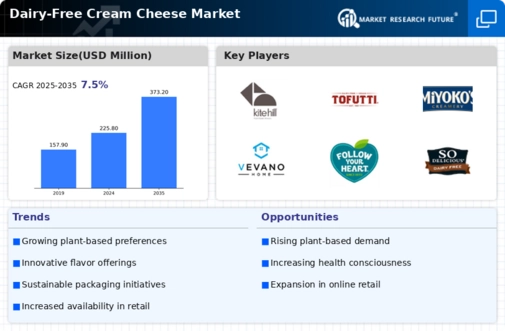Market Analysis
In-depth Analysis of Dairy Free Cream Cheese Market Industry Landscape
The Dairy-Free Cream Cheese Market has experienced noteworthy trends, reflecting the evolving consumer preferences and dietary choices in the food industry. One of the prominent trends driving this market is the increasing demand for plant-based and dairy-free alternatives. As more consumers embrace vegetarian, vegan, or lactose-free lifestyles, the dairy-free cream cheese segment has seen significant growth. Consumers are seeking products that align with their dietary choices without compromising on taste and texture. This trend is in line with the broader shift towards plant-based diets, driven by concerns for animal welfare, environmental sustainability, and personal health.
The health and wellness movement has played a pivotal role in shaping the Dairy-Free Cream Cheese Market. As consumers become more health-conscious and aware of the impact of their food choices on well-being, there is a growing demand for alternatives that are perceived as healthier. Dairy-free cream cheese, often made from plant-based ingredients like nuts, soy, or coconut, is positioned as a lower-calorie and cholesterol-free option. Additionally, many dairy-free cream cheese products are fortified with vitamins and minerals, appealing to consumers who prioritize nutritional benefits in their food choices.
Flavor innovation is another key trend driving the Dairy-Free Cream Cheese Market. Manufacturers are focusing on creating diverse and appealing flavor profiles to cater to the evolving tastes of consumers. From classic plain to savory herbs, garlic, and even exotic fruit-infused varieties, the market is witnessing a surge in creative flavor options. This trend not only adds variety to the product offerings but also attracts consumers looking for unique and indulgent dairy-free alternatives. The diverse flavor landscape contributes to the overall acceptance and popularity of dairy-free cream cheese among consumers with different taste preferences.
The Dairy-Free Cream Cheese Market is also benefiting from the rising awareness of food allergies and intolerances. As lactose intolerance and dairy allergies become more prevalent, individuals are actively seeking substitutes that allow them to enjoy the taste and texture of cream cheese without the discomfort associated with dairy consumption. The dairy-free options, made from alternative ingredients, provide a suitable solution for those with dietary restrictions, expanding the market reach to a broader consumer base.
Sustainability concerns are influencing purchasing decisions, and the Dairy-Free Cream Cheese Market is responding to this demand. Many consumers are not only looking for products that align with their dietary preferences but also support environmentally friendly practices. Manufacturers in this market are increasingly focusing on sustainable sourcing, ethical production processes, and eco-friendly packaging. This commitment to sustainability resonates with environmentally conscious consumers, contributing to the overall appeal and market success of dairy-free cream cheese products.
Digitalization and increased connectivity are impacting the Dairy-Free Cream Cheese Market as well. Social media platforms and online communities provide a space for consumers to share information, recipes, and experiences related to dairy-free living. This has facilitated greater awareness and acceptance of dairy-free alternatives, including cream cheese. The online presence also allows manufacturers to engage directly with consumers, gather feedback, and adapt their products to meet the evolving needs of the market.









Leave a Comment